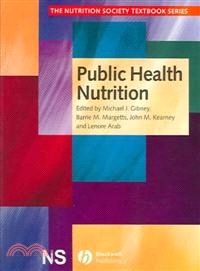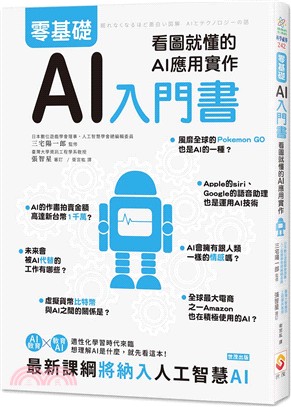商品簡介
- Provide students with the required scientific basis in nutrition, in the context of a systems and health approach.
- Enable teachers and students to explore the core principles of nutrition and to apply these throughout their training to foster critical thinking at all times. Each chapter identifies the key areas of knowledge that must be understood and also the key points of critical thought that must accompany the acquisition of this knowledge.
- Are fully peer reviewed to ensure completeness and clarity of content, as well as to ensure that each book takes a global perspective and is applicable for use by nutritionists and on nutrition courses throughout the world.
Public Health Nutrition is an essential purchase for students majoring in nutrition and dietetics. Public health nutrition as a subject is growing immensely in importance, taking into account the real potential to reduce the burden of non-communicable chronic disease through diet. Professionals in nutrition, dietetics, food science, medicine, community health care and many related health care areas will all find much of great use within the book’s covers. Libraries in all universities, medical schools and establishments teaching and researching in these subject areas should have several copies on their shelves.
OTHER BOOKS IN THE NUTRITION SOCIETY TEXT BOOK SERIES:
Introduction to Human Nutrition: ISBN 0 632 05624 X
Nutrition & Metabolism: ISBN 0 632 05625 8
Clinical Nutrition: ISBN 0 632 05626 6
目次
1.1 Introduction.
1.2 Organization of the book.
1.3 Definitions used in public health.
1.4 What are the key public health problems?
1.5 Food and nutrition policy.
1.6 The public health nutrition cycle.
1.7 Step 1: Identify key nutrition-related problems.
1.8 Step 2: Set goals and broad aims.
1.9 Step 3: Define objectives.
1.10 Step 4: Create quantitative targets.
1.11 Step 5: Develop nutritional programs.
1.12 Step 6: Implementation.
Step 7 Evaluation.
Further reading.
2 Nutritional Epidemiology.
2.1 Introduction.
2.2 Types of study.
2.3 Study design: sampling, study size and power.
2.4 Measuring exposure.
2.5 Measuring outcomes.
2.6 Measuring diet-disease (exposure-outcome) associations.
2.7 Interpretation of associations.
2.8 Expressing results from nutritional epidemiological studies.
2.9 Perspectives on the future.
Further reading.
3 Assessment of Nutritional Status in Individuals and Populations.
3.1 Introduction.
3.2 Dietary assessment.
3.3 Biomarkers as measures for the assessment of nutritional status.
3.4 Anthropometric and other clinical measures.
3.5 Errors in methods of assessment of nutritional status.
3.6 Perspectives on the future.
Further reading.
4 Assessment of physical activity.
4.1 Introduction.
4.2 Definition of commonly used terms.
4.3 Dimensions of physical activity.
4.4 reliability and validity of physical activity assessment instruments.
4.5 Physical activity assessment methods.
4.6 Perspectives on the future.
Further reading.
5 Public Health Nutrition Strategies for Intervention at the Ecological Level.
5.1 Introduction.
5.2 Definition of the ecological approach.
5.3 Individual versus ecological approaches.
5.4 Key principles in the ecological approach.
5.5 Intervention.
5.6 Advantages and disadvantages of this approach.
5.7 Guidelines for using the ecological approach to design nutrition interventions.
5.8 Ethical issues to consider.
5.9 Ecological interventions to change eating habits.
5.10 Perspectives on the future.
Further reading.
6 Public Health Nutrition Strategies for Intervention at the Individual Level.
6.1 Introduction.
6.2 Interventions of supplementary feeding, foods or nutrients.
6.3 Changing Behaviour without giving foods.
6.4 Evaluation of programs and interventions.
6.5 Perspectives on the future.
Further reading.
7 Dietary Guidelines.
7.1 Introduction.
7.2 Overview of dietary recommendations.
7.3 Quantitative dietary guidelines.
7.4 Qualitative Dietary Guidelines.
7.5 Steps involved in devising food-based dietary guidelines.
7.6 Visual presentations of food guides related to dietary guidelines.
7.7 Perspectives on the future directions.
Further reading.
8 Food Choice.
8.1 Introduction.
8.2 The study of food choice.
8.3 Population issues affecting food choice.
8.4 Individual issues affecting food choice.
8.5 Perspectives on the future.
Further reading.
9 Public Health Aspects of Onernutrition.
9.1 Introduction.
9.2 Macronutrients, excess energy intake and overweight.
9.3 Obesity as a determinant of mortality and morbidity.
9.4 Perspectives on the future.
Further reading.
10 Public Health Aspects of Undernutrition.
10.1 Introduction.
10.2 Definitions of undernutritiom.
10.3 Clinical syndromes of undernutrition.
10.4 Micronutrient deficiency: "hidden hunger."
10.5 Time trends and contemporary prevalences.
10.6 Etiology: determinants and conditioning factors for undernutrition.
10.7 Public health consequences of undernutrition.
10.8 Policy and programmatic issues in preventing undernutrition.
10.9 Policy and programmatic issues in reversing undernutrition.
10.10 Perspectives on the future.
Further reading.
11 Vitamin A Deficiency.
11.1 Introduction.
11.2 Consequences of vitamin A deficiency.
11.3 Epidemiology.
11.4 Prevention and control.
11.5 Assessment of vitamin A status.
11.6 Monitoring and evaluation.
11.7 Perspectives on the future.
Further reading.
12 Iodine and Iodine-deficiency Disorders.
12.1 Introduction.
12.2 Definition of iodine deficiency.
12.3 Clinical features.
12.4 Iodine metabolism.
12.5 Reference intakes for iodine.
12.6 Public health aspects of iodine deficiency.
12.7 Management of iodine deficiency.
12.8 Assessment and elimination of iodine deficiency disorders.
12.9 Perspectives on the future.
Further reading.
13 Iron-deficiency Anemias.
13.1 Introduction.
13.2 Definition and clinical features of iron-deficiency anemia.
13.3 Iron metabolism.
13.4 Reference intakes for iron.
13.5 Public health implications of iron-deficiency anemia.
13.6 Perspectives on the future.
Further reading.
14 Fear of Fatness and Fad Slimming Diets.
14.1 Introduction.
14.2 Epidemiology.
14.3 Life-cycle fatness trends.
14.4 Definitions and descriptions.
14.5 Etiology.
14.6 Consequences for public health.
14.7 Prevention strategies.
14.8 Assessing body image.
14.9 Perspectives on the future.
Further reading.
15 Nutrition and Child Development.
15.1 Introduction.
15.2 Child development and the role of the environment.
15.3 Possible mechanisms linking undernutrition to poor development.
15.4 Prevalence of nutritional deficiencies.
15.5 Intrauterine growth retardation.
15.6 Breast-feeding and its influence on child development.
15.7 Wasting, Stunting and severe clinical malnutrition.
15.8 Iron-deficiency anemia.
15.9 Iodine deficiency.
15.10 Zinc deficiency.
15.11 Vitamin A deficiency.
15.12 Studies on the effects of short-term hunger and school feeding.
15.13 Perspectives on the future.
Further reading.
16 Infant Feeding.
16.1 Introduction.
16.2 Role and importance of breast-feeding.
16.3 Barriers to successful breast-feeding.
16.4 Breast-feeding challenges.
16.5 Potential feeding difficulties.
16.6 Breast-feeding and human immunodeficiency virus transmission.
16.7 Infant feeding after 6 months.
16.8 Monitoring the child's growth: the road-to-health.
16.9 Perspectives on the future.
Further reading.
17 Adverse Outcomes in Pregnancy: The Role of Folate and Related B-Vitamins.
17.1 Introduction.
17.2 Biochemical basis for the role of folate in adverse outcomes of pregnancy.
17.3 Evidence that folate and other related vitamins play a protective role against adverse outcomes of pregnancy.
17.4 Prevention of folate-responsive adverse outcomes of pregnancy.
17.5 Perspectives on the future.
Further reading.
18 Maternal nutrition, Fetal Programming And Adult Chronic Disease.
18.1 Introduction.
18.2 Observations establishing the link between size at birth and later cardiovascular disease.
18.3 Potential confounding influences.
18.4 Findings for particular cardiovascular and metabolic disorders.
18.5 Determinants of fetal growth and programming: the importance of fetal nutrition.
18.6 Maternal influences on fetal nutrition.
18.7 Perspectives on the future.
Further reading.
19 Cardiovascular Disease.
19.1 Introduction.
19.2 Epidemiology.
19.3 Correlations between coronary heart disease rates and food intake.
19.4 Prospective observation of subjects for whom diet histories are available.
19.5 Cardiovascular risk factors and their nutritional determinants.
19.6 Clinical trials of cardiovascular risk reduction by dietary modification.
19.7 Nutritional strategies for high-risk populations.
19.8 Perspectives on the future.
Further reading.
20 Diabetes Mellitus.
20.1 Introduction.
20.2 Classification of diabetes.
20.3 Diagnosis of diabetes.
20.4 Risk factors for the development of diabetes.
20.5 Diabetes as a public health issue.
20.6 Prevention and management of diabetes.
20.7 Scope for primary prevention of diabetes.
20.8 Perspectives on the future.
Further reading.
21 Cancer and Diet.
21.1 Introduction.
21.2 Mechanisms of effect of diet.
21.3 Carcinogenesis: initiation, promotion and progression to metastases.
21.4 Gene-nutrient interactions in carcinogenesis.
21.5 Epidemiological studies of diet and cancer.
21.6 Dietary constituents of interest.
21.7 Prevention: preventive potential.
21.8 Prevention guidelines for individuals and populations.
21.9 Perspectives on the future.
Further reading.
22 Disease Prevention: Osteoporosis and Hip Fracture.
22.1 Introduction.
22.2 Definition.
22.3 Epidemiology: the scale of the problem.
22.4 The biology of bone health.
22.5 Perspectives on the future.
Further reading.
Index.
主題書展
更多書展本週66折
您曾經瀏覽過的商品
購物須知
外文書商品之書封,為出版社提供之樣本。實際出貨商品,以出版社所提供之現有版本為主。部份書籍,因出版社供應狀況特殊,匯率將依實際狀況做調整。
無庫存之商品,在您完成訂單程序之後,將以空運的方式為你下單調貨。為了縮短等待的時間,建議您將外文書與其他商品分開下單,以獲得最快的取貨速度,平均調貨時間為1~2個月。
為了保護您的權益,「三民網路書店」提供會員七日商品鑑賞期(收到商品為起始日)。
若要辦理退貨,請在商品鑑賞期內寄回,且商品必須是全新狀態與完整包裝(商品、附件、發票、隨貨贈品等)否則恕不接受退貨。
























